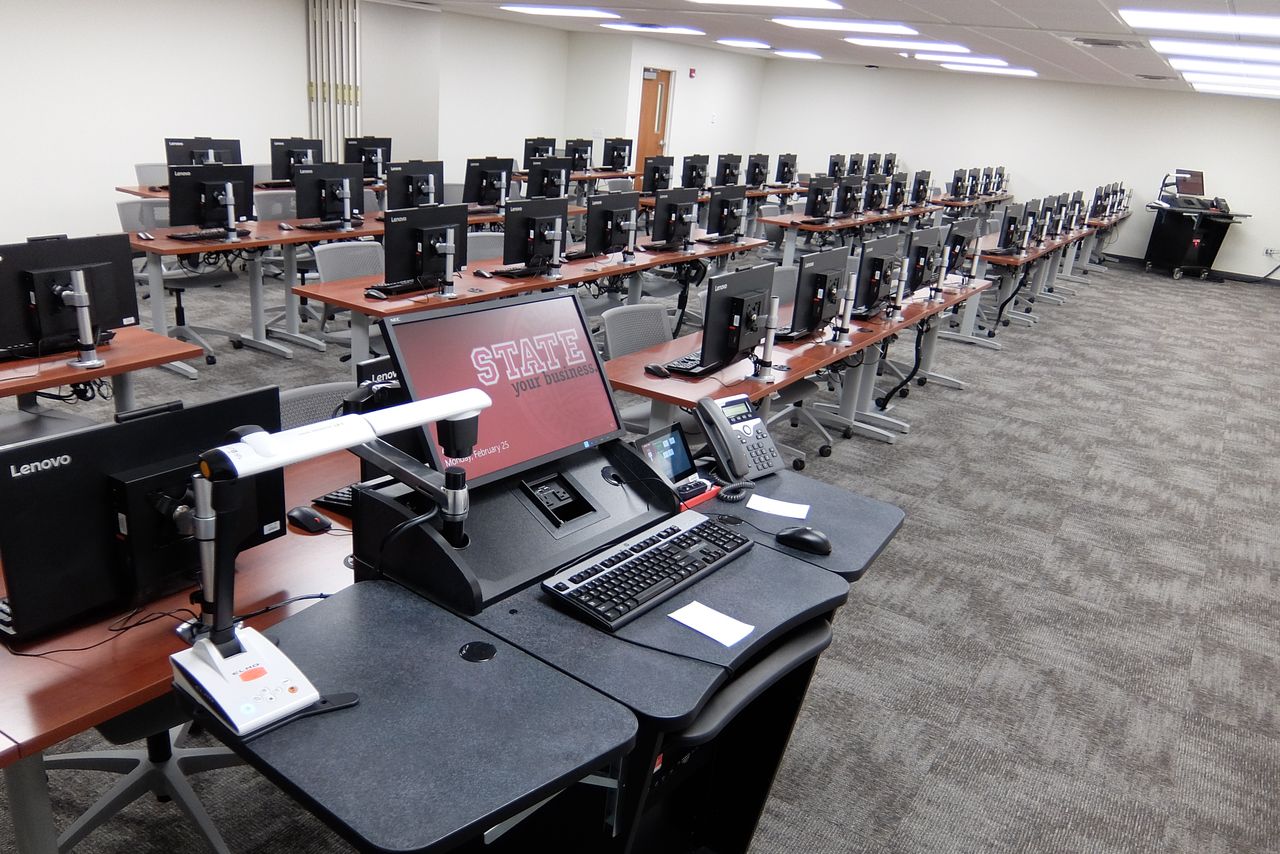The transformation of an unfinished basement area into new lab classrooms in the State Farm Hall of Business is a success story, according to Jeff Grabb, College of Business director of technology and building services.
Grabb described what a large undertaking the renovation project was: “We had five labs on the lower level here. We went to seven, and we really didn’t give up a whole lot other than just storage space. It makes us the single biggest contiguous lab complex on campus for sure for computers. It puts us over 300 seats.”
The project took about a year from design to finish, and the whole thing came in under budget.
“It was the biggest project I’ve ever been a part of from a perspective of having the most pieces,” said Grabb. “Facilities deserves a lot of credit for coordinating dozens and dozens of individuals.”
Originally, the plan was to convert a basement storage area adjacent to the existing computer lab area into two 40-person traditional classrooms, but during the design process, faculty members expressed the need for more space that could be used for computer-enhanced learning.
“(The department chairs) said, ‘What’s actually killing us is our computer lab space. That’s where we’re really feeling the crunch,’” said Grabb. “Most of the (course) sections in the College of Business are 40 seats. We have one computer lab classroom as it exists that matches that number. We have another one that’s got 35, so it was not uncommon that the 35-seater ends up where somebody’s doubling up. Those are usually booked immediately upon the beginning of the semester. So everybody was naturally limited at a certain point.”
Given the need for greater classroom capacity, the decision was made to create two smaller labs with independent audiovisual systems and a dividing wall between them that can be moved out of the way to create one large lab with 60 workspaces.
“It lets us do big training groups on campus for the first time in a way we never could have before,” said Grabb.
Already, the new lab space has been used for a wide range of learning opportunities ranging from marketing analytics visualizations to a theater lighting simulation course to training sessions for Adobe software.
Already, the new lab space has been used for a wide range of learning opportunities ranging from marketing analytics visualizations to a theater lighting simulation course to training sessions for Adobe software.
In addition to helping with capacity issues, another goal in the design process was to maximize students’ workspace on the desks. To achieve this, the monitors were placed on small steel mounts rather than bulky stands. Additionally, small, sleek computers designed to attach to the back of the monitor and that require minimal cabling were selected.
Grabb noted these features help to create a less cluttered looking lab. To further add to the clean, welcoming atmosphere, the new space utilizes efficient LED lighting that utilizes a daytime spectrum.
“It doesn’t feel like you’re in a basement,” said computer support specialist George Wiman.
The renovation also included a new storage closet and resulted in a small study nook by the Bistro. Additionally, space was allocated for a new air handler to support the building’s HVAC system.
“All the other air handlers in the building are five stories up in the attic space in the peak, which means as far as getting air down into the lab and the atrium—heavily populated, heavy heat producing areas—they have to push it all down through duct work,” Wiman said.
Historically, the existing system had trouble combating the amount of heat generated by the computers and people working in the labs.
“We’d always had climate control issues,” Grabb said. “It never got what I would describe as cool (in the lab area) unless no one was here.”
Now the students who come from all over campus to use the College of Business computer labs will find a more comfortable work environment.
Although most students have their own laptops, Grabb noted computer labs are still an essential resource to have on campus. Not only do they provide classes with a place to meet, but they also give students access to specialized, and often expensive, software packages, such as statistical and analytical tools or graphic design resources. Instead of places where people go with the sole purpose of sending emails or doing word processing, computer labs are becoming hubs for services where users can access more complex software packages and utilize resources such as 3D printers.
“The future is going to be interesting, and what we’ve done with this will hopefully get us to that point,” Grabb said as he surveyed the new lab space. “We will now have enough infrastructure with a few tweaks here and there to last us through the next phase of technology.”

